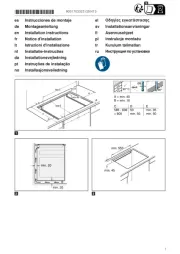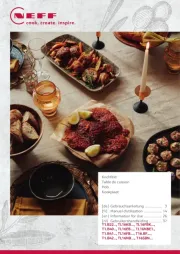Neff B5AVM7HH0B Manual
Læs gratis den danske manual til Neff B5AVM7HH0B (52 sider) i kategorien Ovn. Denne vejledning er vurderet som hjælpsom af 11 personer og har en gennemsnitlig bedømmelse på 4.4 stjerner ud af 6 anmeldelser.
Har du et spørgsmål om Neff B5AVM7HH0B, eller vil du spørge andre brugere om produktet?

Produkt Specifikationer
| Mærke: | Neff |
| Kategori: | Ovn |
| Model: | B5AVM7HH0B |
| Vekselstrømsindgangsspænding: | 220 - 240 V |
| Vekselstrømsindgangsfrekvens: | 50 / 60 Hz |
| Bredde: | 594 mm |
| Dybde: | 548 mm |
| Højde: | 595 mm |
| Vægt: | 41708 g |
| Produktfarve: | Rustfrit stål |
| Kontroltype: | Dreje |
| Lampe type: | Halogen |
| Indbygget skærm: | Ja |
| Skærmtype: | LCD |
| Strøm: | 16 A |
| Ledningslængde: | 1.2 m |
| Pakkedybde: | 660 mm |
| Pakkebredde: | 690 mm |
| Pakkehøjde: | 675 mm |
| Automatisk slukning: | Ja |
| Husmateriale: | Rustfrit stål |
| Placering af apparat: | Indbygget |
| Vandtank volumen: | 0.22 L |
| Indvendig belysning: | Ja |
| Dørhængsel: | Ned |
| Indvendige mål (B x D x H): | 480 x 415 x 357 mm |
| Installationsrum bredde: | 568 mm |
| Installationsrum dybde: | 550 mm |
| Installationsrum højde: | 595 mm |
| Tilsluttet belastning: | 3600 W |
| Grill: | Ja |
| Damp madlavning: | Ja |
| Konvektion madlavning: | Ja |
| Børnesikring: | Ja |
| Understøttede scanningstilstande: | 635 mm |
| Certificering: | CE, VDE |
| Energieffektivitetsskala: | A+++ til D |
| Selvrensende: | Ja |
| Installationsrum højde (min.): | 585 mm |
| Kontrolposition: | Front |
| Nem at rengøre: | Ja |
| Restvarmeindikator: | Ja |
| Wi-Fi kontrolleret: | Ja |
| Energieffektivitetsklasse: | A |
| Rengøringstype: | Pyrolytisk + damp |
| Antal gitre: | 2 |
| Effektiv bakke overfladeareal: | 1290 cm² |
| Kølende ventilator i døren: | Ja |
| Ovn - størrelse: | Medium |
| Ovntype: | Elektrisk ovn |
| Samlet indvendig ovn kapacitet: | 71 L |
| Strøm for samtlige ovne: | 3600 W |
| Antal ovne: | 1 |
| Ovn nettokapacitet: | 71 L |
| Konventionel madlavning: | Ja |
| Pizza fremstillingsfunktion: | Ja |
| Antal lamper: | 1 Lampe( r) |
| Energieffektivitetsindeks (EEI): | 95.3 |
| Energiforbrug (konventionel): | 1.04 kWh |
| Energiforbrug (tvungen konvektion): | 0.81 kWh |
| Hurtig varme: | Ja |
| Udtrækkelige drejeknapper: | Ja |
| Grillrist inkluderet: | Ja |
| Automatiske programmer, antal: | 15 |
| Opvarmning i både top og bund: | Ja |
| Mikroovn madlavning: | Ingen |
| Grill med fuld overflade: | Ja |
| Dør temperatur (maks.): | 30 °C |
| Ovn effekt: | 3600 W |
| Rengøringsteknologi: | Hydrolytisk |
| Dørmateriale: | Glas |
| Brødfremstilling kapacitet: | Ja |
| Installationsrum bredde (min.): | 560 mm |
| Varmluft grill: | Ja |
| Maksimal temperatur (varmluft): | 275 °C |
| Maksimal temperatur (konventionel): | 275 °C |
| Stegetermometer: | Ja |
| Teleskopskinne medfølger: | Ja |
| Pyrolyse effekt: | 4800 W |
| Roaster funktion: | Ja |
Har du brug for hjælp?
Hvis du har brug for hjælp til Neff B5AVM7HH0B stil et spørgsmål nedenfor, og andre brugere vil svare dig
Ovn Neff Manualer










Ovn Manualer
- Airforce
- Hyundai
- Blaze
- Jata
- Fisher & Paykel
- XO
- Summit
- Elba
- Atlas
- Waring Commercial
- Dash
- Furrion
- Winia
- Meireles
- Ribimex
Nyeste Ovn Manualer









